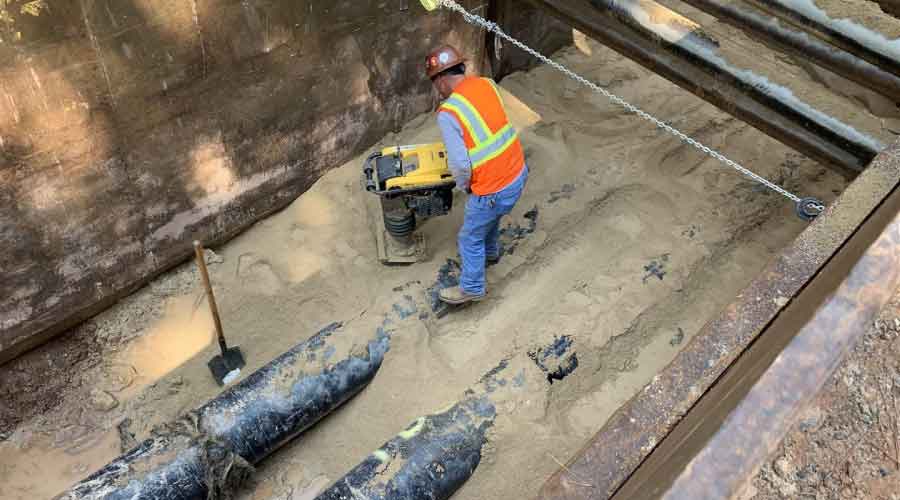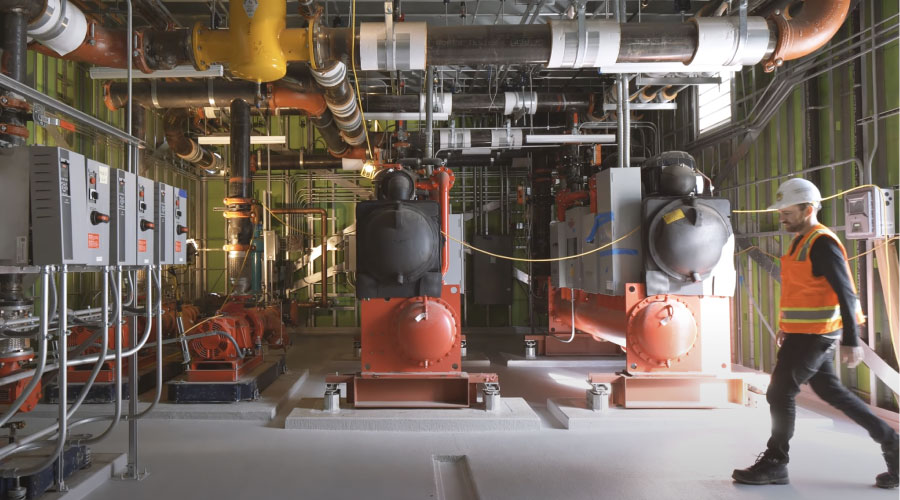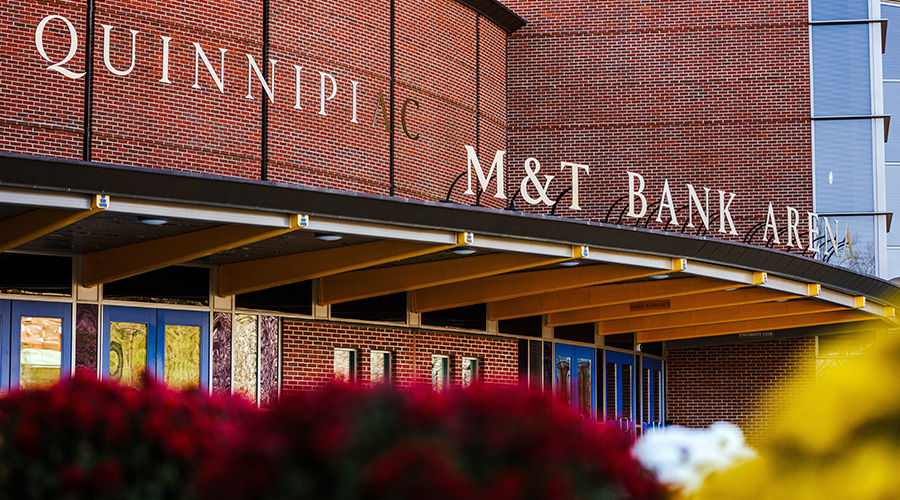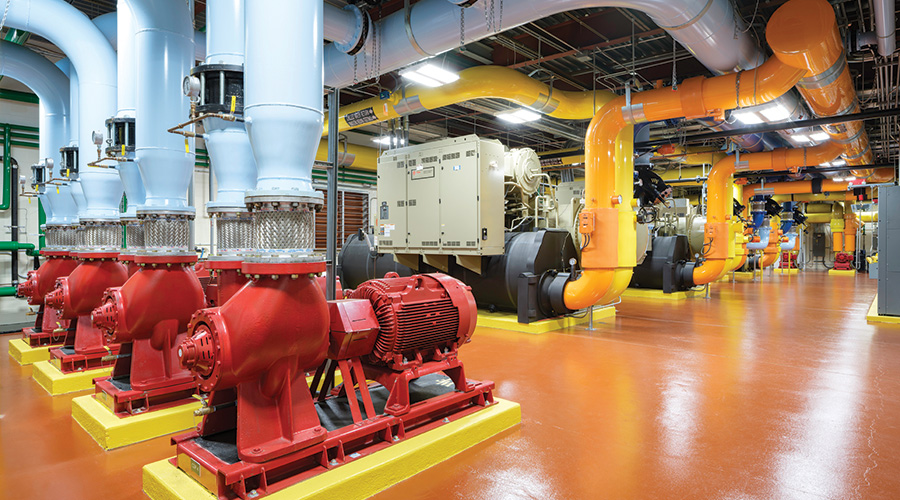Thermal Distribution Systems: Overcoming Installation Challenges
If installed correctly, these systems can reduce campus energy usage and improve reliability.
By Matthew Boatwright, Contributing Writer
Consider what’s hidden under the sidewalks and inside the higher education buildings students visit?
Running underneath people’s feet and up the walls are highly sophisticated MEP systems and HVAC ductwork, hidden from plain view but integral to the functionality of the university campus. Structural systems are wrapped in plaster and other forms of cladding. Facility personnel tuck away the very building components that keep the institutions operable and enable them to function. Out of sight and mind, safe in the knowledge the building itself will keep occupants temperate, healthy, and protected from external harm.
Similarly critical, but often overlooked, are underground thermal distribution systems.
Serving as a bridge between civil and mechanical engineering systems, improperly installed and maintained thermal systems will inevitably prevent the campus building from functioning as designed to support its users.
The challenges associated with installing thermal systems are a matter of nuance. A civil contractor may be an expert on traditional sanitary and domestic water lines, but likely won’t grasp the intricacies of complex mechanical systems. Meanwhile, a mechanical contractor may know those systems top to bottom but not understand the essential earthwork principles required for proper installation, testing, backfilling, and maintenance of the underground pipelines.
The bottom line is thermal distribution systems have been around for quite some time. While their levels of sophistication and technical integration with other building systems have advanced, the basic principles of their mechanics have remained steadfast. And yet, many installers still largely misunderstand how thermal systems need to be designed and constructed.
The following insights aim to highlight the importance of balancing traditional earthwork and utility approaches with mechanical system nuances.
Installing and staging on campus
Underground thermal utilities, such as steam, hot water, and chilled water, are installed in a variety of methods and systems, such as walkable tunnels, inaccessible concrete trenches, and pre-fabricated, pre-insulated pipeline systems. Each of these systems have their own keys to success. The guidance found here focuses on optimizing the lifespan of direct buried pre-fabricated, pre-insulated piping systems. Above all else, the pipe systems that distribute thermal utilities must be watertight. Like most technical building issues, this is easier said than done.
When starting the process of preparing the trench bed and storing pipeline, it’s paramount that the full length of pipe be uniformly supported and insulated. Further, when excavating the ditch, the pipe must be laid on a smooth layer of sand to protect it. If, for example, a 40-foot length of pipe is only supported on either end, in due time, the weight of the pipe will compress the insulation at the support points, which will allow heat to escape and damage the systems outer jacketing. In such an event, groundwater can enter the system, and immediately begin to corrode and destroy the pipeline.
This earthwork principle is a critical consideration. However, thermal systems differ from civil systems in that more room within the pipes is required to allow for the joining and welding of sequential pieces. (Pre-fabricated thermal systems are composed of pipes within pipes; see next section for more detail.) These separate pieces come together like LEGO sets in that they must be assembled in a certain order for the system to work properly.
Case in point, pipe ends that have yet to be interconnected must be protected from any dirt or debris entering, which can damage the system from within. In the event such a system is being installed in an area with a high-water table, temporary sump pumps must be installed to always keep water levels down. Otherwise, if the interior steel pipe (aka service line) gets wet, rust particles can form and gradually worsen the system’s performance and cause major issues and damage downstream connected equipment.
Optimizing thermal distribution
Another key difference between thermal distribution systems and traditional civil systems concerns the materials used.
Civil utilities are typically made using strong, rigid materials like ductile iron or concrete. Pre-fabricated piping systems, on the other hand, comprise a pipe within a pipe. The outer jacket— often made from a comparatively delicate HDPE plastic—must allow for the inner system to expand as it heats up. The handling, transport, and installation of this sensitive material is a huge undertaking.
A properly installed system on campus can last upwards of 50 years, making the overall costs for developers worth the long-term investment. (Some materials alone can cost up to $1,000 per foot.) If internal components are not installed properly, the amount of disruption this can cause to entire campuses and neighborhoods is matched only by the millions of dollars required to repair or replace a system that has been corroded to the point of inoperability.
To avoid such an outcome, one of the most important aspects to consider when optimizing thermal systems is the backfill.
To protect a pipe’s outer plastic jacket as well as the interior service line, the entire system must be backfilled with the proper bedding material, such as washed sand. This material, though expensive, creates a uniform bedding that compacts easily, fills in cracks, and dries quickly. Alternative backfill materials, such native soils or processed aggregate, can often be installed at a lower initial cost, but can damage the outer jacket and cause major issues down the road. Some native soils may be classified as suitable for backfill in standard Earthwork specifications but are not suitable bedding materials for thermal distribution systems.
If these optimization steps are not executed correctly and precisely, the implications can be grave.
Testing systems
Welding and installing thermal distribution field joints is a highly technical process. Even skilled installers can unknowingly have small inclusions or irregularities that can evolve into major issues over time.
To avoid the catastrophic repercussions that can stem from even the smallest mistake, testing of the outer jacket and service line is imperative.
There are two common testing options for consideration to ensure the weld points along the service line are sound and no leaks will occur: a radiographic scan, similar to an X-ray; or an ultrasonic scan, similar to a sonogram. After completion of weld inspections, a hydrostatic pressure test of the full length of pipeline provides an additional layer of insurance that the system is installed correctly. High temperature thermal distribution systems like High Pressure Steam and Condensate and High Temp Hot Water require an intermediate steel conduit to create an air gap within the system that allows the service pipe to expand and contract while the outer jacket remains stationary. This intermediate conduit should be air tested to guarantee it is fully sealed and can be galvanized to provide a second layer of protection.
Finally, the outer jacket should be joined using pressure testable joint kits as the first line of defense against water intrusion. It is imperative to test each component of the system prior to fully backfilling, restoring the surface, and opening the project site back up to campus.
Economic considerations
Installing thermal distribution systems has significant associated costs. If not done correctly, the systems fail prematurely. Therefore, facility leaders have a strong desire to make certain the systems are installed using the correct methods.
With that in mind, some owners and developers inevitably ask if there is a way to design these systems with less cost. The short answer is yes, but a less cost set of products means a shorter lifecycle, and winds up not being the more economical choice over the long term.
On a macro scale, one option that is by no means less expensive but does make addressing maintenance issues more manageable is to install the lines inside an accessible concrete tunnel. All thermal system piping can be run through it and the structure itself is vast enough for workers to easily access equipment and perform preventive maintenance.
This option is beneficial on several levels, from installation and optimization to testing and maintenance. However, many facility owners have difficulty obtaining funding for underground infrastructure systems that are largely buried and forgotten about by the general public.
Thermal distribution systems are tried and true, and support district energy systems that decrease campus energy usage while increasing reliability. Knowledge of their benefits is widespread and rarely challenged among higher education facility stakeholders.
It’s the installation and optimization processes that still present stakeholders with headaches. Facility leaders aren’t in the dark when it comes to such issues, and yet, many have already experienced the hardship of a new system that has problems a few years after installation.
Testing options and upgrades can offer reassurances that a system was installed properly and has a long lifespan when combined with following manufacturer guidelines. But knowing how to properly test and which upgrades to invest in is all contingent on understanding how civil engineering and earthwork principles apply to these systems.
Thermal distribution systems are not just mechanical or civil in nature, they are a coordinated effort, from start to finish.
It is essential for higher education facility leaders to partner with the right experts to get the job done correctly, experts who can be a bridge between the civil and mechanical arenas of knowledge.
Knowing the mechanics alone is a good start. Having detailed assessments of campus site and atmospheric conditions, saturation zones, soil quality, and more are the ingredients to ensuring that expensive thermal systems are worth the long-term investment.
Matthew Boatwright, PE, is Project Manager at RMF Engineering, Inc. He can be reached at matthew.boatwright@rmf.com.
Related Topics:












